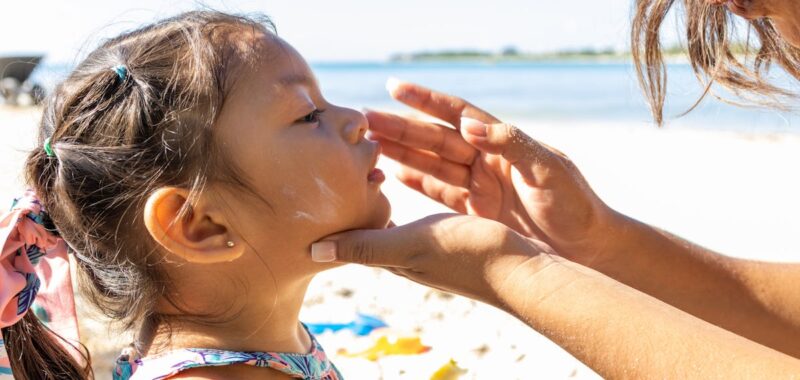I always slather my kids in sunscreen when we’re outside, considering it mostly a preventative measure. We’ve all heard how sunburns early in life increase the odds of skin cancer later in life, right? So, I just felt like by being the obnoxious sunblock-helicopter-mom, I was hopefully helping to keep my kids skin-cancer-free in their adult years. But recently, one of my friends mentioned that her nephew had been diagnosed with melanoma, and I started doing the classic parental fear crashout. How common is skin cancer in kids? Should I be doing skin checks more often on my now moody, sometimes body-conscious, young teens?
To help get a better understanding (read: quell my rising panic) of the occurrence of skin cancer in kids, and what parents should be looking for and doing proactively, I asked two doctors for their expert insight: double-board-certified dermatologist Dr. Viktoryia Kazlosukaya, owner of clinic Dermatology Circle in New York City, and Dr. Daniel Atkinson, the GP clinical lead at online health service company Treated.com.
Here’s what they had to share.
So… kids can get skin cancer?
Unfortunately, yes. As is the case with most cancers, certain risk factors may make some children more susceptible than others. “Although it’s rare, children can get skin cancer,” Atkins says. “It’s not as likely to occur in children as it is in adults, but the risk is elevated for children who are light-skinned, have a family history of skin cancer, or spend a lot of time in the sun.”
The way that skin cancer presents in kids often looks different from what it does in adults, in more ways than one.
“In adults, the most common skin cancers are basal and squamous cell carcinomas, typically linked to cumulative sun exposure,” explains Kazlosukaya. “While children can also develop these cancers, they’re usually driven by genetic mutations rather than environmental factors. For example, nevoid basal cell carcinoma syndrome (NBCCS), also known as Gorlin syndrome, is a rare condition that causes numerous basal cell carcinomas to develop from an early age, along with other symptoms. Another is xeroderma pigmentosum, where a genetic defect in the DNA repair system leads to a significantly increased risk of skin cancers in childhood.”
There are other rare conditions too, Kazlosukaya points out, but the big takeaway is that they’re (thankfully) uncommon.
What is the most common skin cancer among kids, then? Melanoma. “Each year, around 500–700 cases of melanoma are diagnosed in children in the U.S.,” says Kazlosukaya.
But again, it’s not necessarily the same as it is with adults. “Pediatric melanomas often arise from different mutations than adult cases. They’re less commonly associated with sun exposure,” Kazlosukaya continues, adding with emphasis, “That doesn’t mean sun protection isn’t important.”
What should I be looking for?
You can start by looking for the same things you look for when you do your own skin check. Need a refresher?
“It can look like a standard mole, but there are some features that can help distinguish it from a normal mole and a cancerous one,” Atkinson says. He says you can look for:
- Asymmetry — Does one half look different from the other?
- Border — Is the edge irregular or ragged?
- Color — Is it tan, brown, and black?
- Diameter — Is the mole around 6mm?
- Evolving — Has it changed over time (in size and color)?
“If the answer is ‘yes’ to any of the above questions, it’s best to get them checked out. The earlier you detect skin cancer, the better the prognosis.”
Kazlouskaya adds that melanoma in kids may not look like the classic dark spots seen in adults. “Instead, they can appear pink and pimple-like,” she shares, “making them easier to overlook.”
How can you protect your children?
OK, so we know we should be applying sunscreen on our kids (or having them do it themselves under our watchful eyes once they’re too cool for Mom to help). We need specifics, though. What, exactly, should we be doing to give our kids the best sun protection possible?
“Sunscreen is key,” underscores Atkinson. “Aim for an SPF of 50 or higher for optimum protection. Apply it 30 minutes before sun exposure, and reapply it every two hours and immediately after being in water, even if it’s water-resistant.”
And, sure, you may see that SPF level vary according to different doctors and organizations… but not by much. I’m inclined to err on the side of caution and stick with 50+, but the American Academy of Dermatology says you should be good if you go with an SPF of at least 30 or higher.
“Aside from sunscreen, limit sun exposure, particularly between peak sun times. You don’t need to avoid going outside; just stay in shaded areas to avoid direct sunlight,” says Atkinson. “Additionally, cover your child’s skin as much as possible. Shorts and a short-sleeved top may seem like the go-to summer outfit, but the more you cover, the better. Stick to lightweight, breathable fabrics like cotton or linen; these will help keep kids cool when staying covered.”
Finally, you should be doing regular skin checks with your kids just to keep an eye out for “anything unusual that may indicate a cancerous mole.”
Who should you contact?
If you do notice something suspicious, go ahead and set up an appointment with your child’s pediatrician or your family’s primary care physician. “They’ll do the initial assessments, and if they suspect skin cancer, they’ll refer you to a dermatologist,” says Atkinson.
Of course, if you already have a dermatologist you know and trust who’ll see kids, feel free to reach out to them directly. “Bottom line? Even in kids, early detection and sun protection matter,” Kazlosukaya tells us. “Stay aware, and when in doubt, have it checked!”

